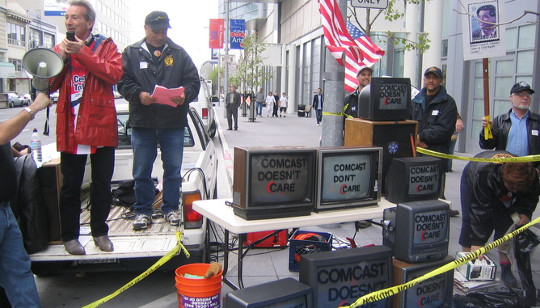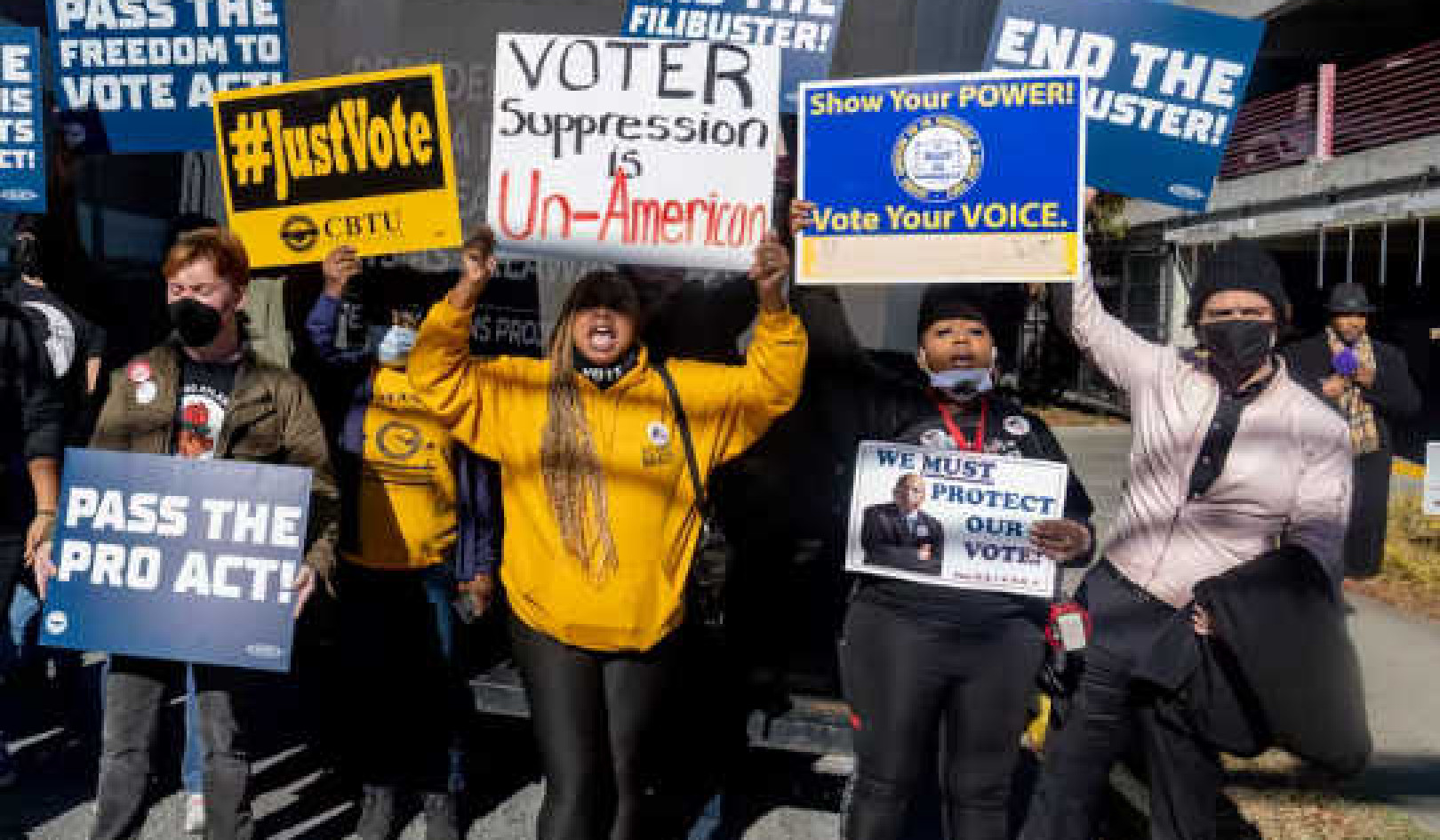 Americans get fed up with what the big providers are willing to provide and at what pricSteve Rhodes, CC BY-NC-SA
Americans get fed up with what the big providers are willing to provide and at what pricSteve Rhodes, CC BY-NC-SA
 o one disputes the importance of affordable access to high-speed internet for economic growth in the 21st century. The United States has seen consistent and rapid growth in its broadband infrastructure since the internet became popular in the 1990s, offering more households and businesses connectivity at faster speeds.
o one disputes the importance of affordable access to high-speed internet for economic growth in the 21st century. The United States has seen consistent and rapid growth in its broadband infrastructure since the internet became popular in the 1990s, offering more households and businesses connectivity at faster speeds.
However, rather than leading the world, the United States is drifting towards mediocrity. Compared to the global leaders, consumers in the US pay higher prices, average connectivity speeds are in the middle of the pack and household penetration rates are far from the top.
Although geography, demographics and demand partly explain the situation, the most obvious culprit is the dearth of competition in broadband markets. But that could change. Twenty states currently restrict what local governments can do in deploying their own broadband infrastructure to compete with the big providers. Now, the Federal Communications Commission appears to be on the verge of making changes that could make it easier for individual communities to invest in their own broadband infrastructure.
State of The Union’s Internet Connection
A majority of the US is served by two providers: a cable company and telecom company. A small proportion of households, about 15%, have a third option. A quarter of households have one broadband provider or less. As we consider high speeds, the picture is more dismal. A 10 Mbps connection is not available for two out of five households, and three out of four households have one or fewer options at 25 Mbps. A 25 Mbps connection, which typically costs more than US$50 in US cities, costs US$24 in London, US$28 in Seoul, and US$31 in Paris. In France, triple play packages have typically been priced at 30 euro (about US$35). A price war in February 2014 brought the price down to 20 euro.
It’s no mystery why there’s so little competition for internet access in the US. Unlike European countries and a large majority of OECD countries, the US has abandoned policies that require the sharing of infrastructure with competing broadband providers. Instead, the US has taken a deregulatory approach that requires competitors to build their own infrastructure in order to enter the market.
Rewiring neighborhoods and homes is expensive. It costs approximately US$700-800 per house to run new fiber infrastructure through a neighborhood and another US$600-700 to make each household connection. In order to upgrade parts of its infrastructure to offer its fiber-to-the-home service, FiOS, Verizon invested US$23
billion To Run Fiber Past 18 Million Homes In The US.
Municipalities Take Matters Into Own Hands
For communities with poor broadband connectivity, there are few options: wait for the cable and telecommunication providers to decide it is in their interests to upgrade their systems, convince Google Fiber to wire up your community or build your own.
This is no small decision. Wiring a community with new fiber is expensive, and what it buys you is the ability to compete against existing cable and telecom incumbents who will do everything within their power to discourage you from eating into their profits.
But despite the risks and high capital costs, this is just what a growing number of communities in the US are choosing to do, in places including Rockport, Maine; Chanute, Kansas; and Powell, Wyoming The projects underway now number in the hundreds. In my own research, the most common reason I hear comes not from communities without broadband, but from those communities poorly served by existing broadband providers.
Incumbent broadband providers have responded to community broadband projects with lawsuits, steep price cuts, public relations campaigns and lobbying at the state level to inhibit community-based broadband competition. Twenty states have enacted such legislation using a wide range of measures: banning retail sales, restricting the use of public finance, requiring referendums and instituting profitability thresholds, among others. While many of the requirements appear reasonable at first glance, they are designed to open up avenues for litigation and to introduce costly delays.
The principal arguments put forward against municipal broadband networks are that the government should not be involved in broadband infrastructure as the market is working fine, that this constitutes unfair competition against private sector alternatives, and that municipal broadband projects tend to fail and leave tax payers saddled with high debts to pay off. The rationale for state intervention is thus to save local communities from making costly mistakes.
No doubt, the learning curve has been steep for many of the pioneers of municipal broadband. Burlington Telecom, a municipal project in Vermont, ran into financial trouble and has been sold to a local business. The Utopia project in Utah, a consortium of cities, is negotiating a sale of its network to complete the build-out of its network and resolve financial problems. The municipal network in Provo, Utah was sold to Google Fiber for $1. Another set of communities have demonstrated signs of success, including Chattanooga, Tennessee; Bristol, Virginia; Lafayette, Louisiana; Santa Monica, California; Cedar Falls, Iowa; and Wilson, North Carolina.
The common feature in each of these examples is that the public investments have boosted competition and brought businesses and households in their regions faster broadband at better prices. Even those projects that have struggled to pay back their debts,for example in Monticello, Minnesota, have stimulated broadband providers to offer better service at better prices.
Obama Throws Down The Gauntlet
The decision to allow municipalities to invest in broadband infrastructure is solely at the discretion of the FCC, an independent agency. But President Obama has provided his endorsement and backing by coming out strongly in favor of removing these obstacles — obstacles put into place with the encouragement and support of cable and telecommunications providers. Obama has also promised assistance for communities through a new project, Broadband USA, which will “provide communities with proven solutions to address problems in broadband infrastructure planning, financing, construction, and operations across many types of business models.”
Following his stand on net neutrality, this is the second time the Obama administration has chosen to wage war against the biggest players in the telecommunications industry, including Comcast, Time Warner, AT&T and Verizon, among others.
The prospects for major changes in broadband competition policy in Washington D.C. appear to be remote. That may matter less if communities are able to take matters into their hands. We may be on the cusp of a substantial shift in broadband policy away from Washington towards decisionmakers in communities across the country. The stakes are high. Expect the fight to vicious.
This article was originally published on The Conversation
Read the original article.
About The Author
 Robert Faris is the Research Director of the Berkman Center for Internet and Society at Harvard University. His recent research includes Internet content regulation, state censorship and surveillance practices, broadband and infrastructure policy, and the interaction of new media, online speech, government regulation of the Internet and political processes. He is currently working on the integration and comparison of analytical tools to better understand the structure of online communities and digital media content.
Robert Faris is the Research Director of the Berkman Center for Internet and Society at Harvard University. His recent research includes Internet content regulation, state censorship and surveillance practices, broadband and infrastructure policy, and the interaction of new media, online speech, government regulation of the Internet and political processes. He is currently working on the integration and comparison of analytical tools to better understand the structure of online communities and digital media content.
InnerSelf Recommended Book:
The Metropolitan Revolution: How Cities and Metros Are Fixing Our Broken Politics and Fragile Economy -- by Bruce Katz and Jennifer Bradley.
 Across the US, cities and metropolitan areas are facing huge economic and competitive challenges that Washington won’t, or can’t, solve. The good news is that networks of metropolitan leaders – mayors, business and labor leaders, educators, and philanthropists – are stepping up and powering the nation forward. In The Metropolitan Revolution, Bruce Katz and Jennifer Bradley highlight success stories and the people behind them. The lessons in this book can help other cities meet their challenges. Change is happening, and every community in the country can benefit. Change happens where we live, and if leaders won’t do it, citizens should demand it.
Across the US, cities and metropolitan areas are facing huge economic and competitive challenges that Washington won’t, or can’t, solve. The good news is that networks of metropolitan leaders – mayors, business and labor leaders, educators, and philanthropists – are stepping up and powering the nation forward. In The Metropolitan Revolution, Bruce Katz and Jennifer Bradley highlight success stories and the people behind them. The lessons in this book can help other cities meet their challenges. Change is happening, and every community in the country can benefit. Change happens where we live, and if leaders won’t do it, citizens should demand it.
Click here for more info and/or to order this book on Amazon.























